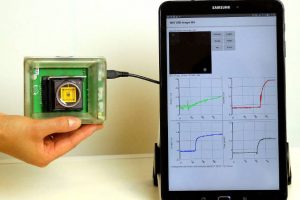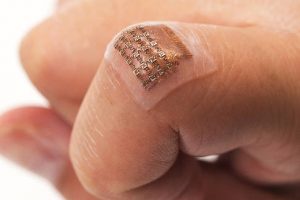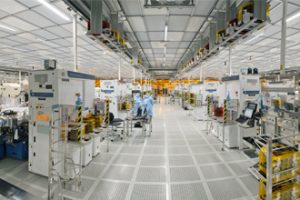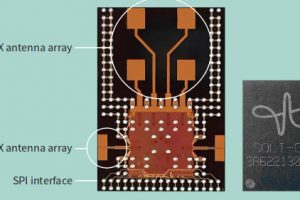The University of Glasgow has used CMOS chip to analyse concentrations of four body chemicals that are indicators of disease, and has achieved results similar to standard NHS tests. The 3.4 x 3.6mm chips were designed on Cadence Virtuoso and fabricated at Austria microsystems on a 350nm triple-well process. On these, the active area is a 16 × 16 array sensors covering 1.6 x ...
Medical Electronics
Content related to medical electronics
Stamp-sized stick-on ultrasound array scans 40mm into body – measures deep blood pressure
A coin-sized flexible stick-on ultrasonic phased-array that allows blood pressure to be measured in arteries
Broadband infra-red LED for food spectroscopy by phone
Osram has introduced SFH 4776, a boadband infra-red in the firm’s 2.75 x 2.0 x 0.6mm high Synios package. The technology inside is a blue-emitting GaN die and phosphor converter, specially developed for spectroscopy, that converts the blue light into radiation across 650 to 1,050nm. “By making improvements to the phosphor material, developers at Osram Opto Semiconductors have succeeded in increasing the intensity ...
Simplified power motor controls
Simplifying the design of low-to-mid-power motor controls in the 7V-45V range
Mini radar and AI instead of finger-pricking for diabetics?
Instead of finger pricking, a miniature radar might one day tell diabetics what their blood-sugar level is, according to the University of Waterloo in Canada. “We want to sense blood inside the body without actually having to sample any fluid,” said engineer Professor George Shaker. “Our hope is this can be realised as a smart watch to monitor glucose continuously.” ...
TI aims at automotive and industry with high-performance ~30V op-amps
TI has revealed early fruits from the latest in its long-running series of BiCom advanced bipolar processes: the 27V 200MHz low-noise OPA2810 and the 36V zero-drift 14MHz OPA189, which are aimed at signal conditioning in automotive and industrial environments. “These are the first few of many other amplifiers focussed in this area, the beginning of a long road of high ...
Supercaps used in Powerbox 2.5kW UPS
Powerbox used 29F of supercapacitors to deliver 2.5kW of back-up power to an industrial controller
Newcastle scientists 3D print human corneas
The first human corneas to be 3D printed have been developed by scientists at Newcastle University. It means the technique could be used in the future to ensure an unlimited supply of corneas. As the outermost layer of the human eye, the cornea has an important role in focusing vision. Yet there is a significant shortage of corneas available to ...
Eye tracking glasses sense eye’s natural dipole
IMEC's wireless eye tracking glasses run for 10 hours without re-charging.
PM to bring AI into the NHS for early diagnoses
Prime Minister Theresa May is to speak today about the use of AI in the NHS to provide early diagnoses. “Late diagnosis of otherwise treatable illnesses is one of the biggest causes of avoidable deaths,” the PM is expected to say, “and the development of smart technologies to analyse great quantities of data quickly and with a higher degree of ...
 Electronics Weekly Electronics Design & Components Tech News
Electronics Weekly Electronics Design & Components Tech News









